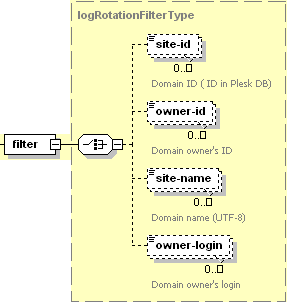Available Filters
Filtering is the way the request XML packet indicates the object (a web user or several) to which the operation will be applied. The request XML packet filters web user accounts using a special <filter> node.
Parameters, nested in the filter node are called filtering rule. A filter contains as many different filtering rule types as the number of different parameters nested in the XML presentation of the filter node. A single operation can use only parameters of the same type in the filtering rule.
Log Rotation Filter
The filter for this operator is presented by type
logRotationFilterType (logrotation.xsd) and structured as follows:

- The site-id node is required. It specifies ID of a site. Data type: integer.
- The owner-id node is required. It specifies ID of a customer. Data type: integer.
- The site-name node is required. It specifies the site name. Data type: string (UTF-8).
- The customer-login node is required. It specifies the customer login name. Data type: string.
Remarks
The filter node can be left blank (<filter/>). In this case all sites available for user specified by login credentials will be matched.
A single filter can specify multiple sites defined either by ID, name, customer ID or customer name in the second. For example, the filter that matches all sites of the customers with IDs 8,9, and 10 looks as follows:
<filter>
<owner-id>8</owner-id>
<owner-id>9</owner-id>
<owner-id>10</owner-id>
</filter>
filter-id

If an operation in a request packet uses filters, the filter-id node is nested in a response packet. It returns the filtering rule parameter. If one of the following values was set as a filter rule parameter, it is returned in the filter-id node of the response packet.
- Domain ID
- Domain name
- Customer ID
- Customer login name
It is done to trace request parameters in case of error. Data type: anySimple.